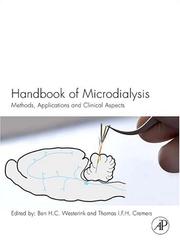| Listing 1 - 10 of 26 | << page >> |
Sort by
|
Book
ISBN: 1349059323 Year: 1981 Publisher: London : Palgrave Macmillan,
Abstract | Keywords | Export | Availability | Bookmark
 Loading...
Loading...Choose an application
- Reference Manager
- EndNote
- RefWorks (Direct export to RefWorks)
Book
ISBN: 981197327X 9811973261 Year: 2023 Publisher: Gateway East, Singapore : Springer,
Abstract | Keywords | Export | Availability | Bookmark
 Loading...
Loading...Choose an application
- Reference Manager
- EndNote
- RefWorks (Direct export to RefWorks)
Iron --- Brain chemistry. --- Physiological effect. --- Brain --- Neurochemistry --- Analysis and chemistry
Book
ISBN: 0128018771 0128018291 9780128018774 9780128018293 Year: 2016 Publisher: Amsterdam, Netherlands : Academic Press,
Abstract | Keywords | Export | Availability | Bookmark
 Loading...
Loading...Choose an application
- Reference Manager
- EndNote
- RefWorks (Direct export to RefWorks)
Schizophrenia. --- Neurobiology. --- Neurosciences --- Dementia praecox --- Schizophrenic disorders --- Psychoses --- Schizotypal personality disorder --- Schizophrenia --- Brain Chemistry --- physiopathology. --- physiology.
Book
ISBN: 0128131586 0128131594 9780128131596 9780128131589 Year: 2019 Publisher: London, England : Academic Press,
Abstract | Keywords | Export | Availability | Bookmark
 Loading...
Loading...Choose an application
- Reference Manager
- EndNote
- RefWorks (Direct export to RefWorks)
"Oligodendroglioma: Clinical Presentation, Pathology, Molecular Biology, Imaging, and Treatment features the latest "cutting edge" information related to molecular biology, molecular therapeutics, imaging, immunotherapy, and research methods on the topic of oligodendrogliomas. The most detailed and comprehensive single volume resource is provided on the subject; it also provides up-to-date information on clinical presentation, pathology, molecular biology, and treatment methods, including immunotherapy. This book is critical for students, physicians, and researchers in the fields of neuroscience, neuro-oncology, neurosurgery, radiation oncology, medical oncology, and others working in the research field or with patients"--
Oligodendroglia. --- Gliomas. --- Oligodendroglioma --- diagnosis. --- pathology. --- therapy. --- Mesoglia --- Nervous system --- Tumors --- Brain chemistry.
Book
Abstract | Keywords | Export | Availability | Bookmark
 Loading...
Loading...Choose an application
- Reference Manager
- EndNote
- RefWorks (Direct export to RefWorks)
Lipids are the most abundant organic compounds found in the brain, accounting for up to 50% of its dry weight. The brain lipidome includes several thousands of distinct biochemical structures whose expression may greatly vary according to age, gender, brain region, cell type, as well as subcellular localization. In synaptic membranes, brain lipids specifically interact with neurotransmitter receptors and control their activity. Moreover, brain lipids play a key role in the generation and neurotoxicity of amyloidogenic proteins involved in the pathophysiology of neurological diseases. The aim
Brain Chemistry. --- Brain Diseases. --- Lipids. --- Lipid Metabolism. --- Synaptic Transmission. --- Membrane Microdomains.
Book
Abstract | Keywords | Export | Availability | Bookmark
 Loading...
Loading...Choose an application
- Reference Manager
- EndNote
- RefWorks (Direct export to RefWorks)
Neuroenhancement (NE) is a behavior conceptualized as the use of a potentially psychoactive substance to enhance ones’ already proficient cognitive capacities. Depending on the specific definitions used, prevalence estimates vary greatly between very low 0.3% (for illicit substances) to astonishingly high 89% (for freely available lifestyle substances). These variations indicate that further research and more conceptual and theoretical clarification of the NE construct is dearly needed. The contributions of this research topic aim to do just that. Specific questions addressed are: How prevalent is NE behavior? How can NE research profit from the already more evolved field of social science research on doping in sports? How is NE perceived by the public? What psychological processes and variables play a role in the decision to neuroenhance? A wide array of methodological approaches is used to investigate these questions. The topics contributions range from theoretical to experimental accounts on NE, and they utilize a diverse set of methods ranging from qualitative to neuroscientific approaches. The research presented here represents a first step towards what we have labeled a psychological approach to NE. By addressing the questions above this research topic hopefully advances our understanding of NE behavior. As with every new field of research, new answers always prompt new questions. In light of what we know now about NE, we hope that the findings presented here will be pursued by other researchers in the future. Clearly, the endeavor to understand NE behavior has only just begun.
Brain chemistry. --- Central nervous system stimulants. --- neuroenhancement --- performance enhancement --- Doping --- Behavior --- cognitive enhancement

ISBN: 9780444522764 044452276X 9780080469669 0080469663 9786610751839 1280751835 Year: 2006 Publisher: Amsterdam ; London : Elsevier,
Abstract | Keywords | Export | Availability | Bookmark
 Loading...
Loading...Choose an application
- Reference Manager
- EndNote
- RefWorks (Direct export to RefWorks)
Microdialysis is currently one of the most important in vivo sampling methods in physiology and pharmacology. It is used to determine the chemical components of the fluid in the extracellular space of tissues. The technique is now well established in neuroscience research and is used excessively in behavioral neuroscience to determine the concentrations and identities of molecules in brain tissues, and their change due to behavior, hormonal and transmitter changes in the nervous system. The book provides a detailed comprehensive overview of the technology and its applications, including ap
Brain microdialysis. --- Internal medicine. --- Medicine, Internal --- Medicine --- Cerebral microdialysis --- In vivo brain microdialysis --- Microdialysis, Brain --- Brain chemistry --- Dialysis
Book
ISBN: 0199914028 9780199914029 1306197406 9781306197403 9780199914012 019991401X Year: 2014 Publisher: New York : Oxford, University Press,
Abstract | Keywords | Export | Availability | Bookmark
 Loading...
Loading...Choose an application
- Reference Manager
- EndNote
- RefWorks (Direct export to RefWorks)
We're all familiar with the idea that plant-derived chemicals can have an impact on the functioning of the human brain. Most of us reach for a cup of coffee or tea in the morning, many of us occasionally eat some chocolate, some smoke a cigarette or take an herbal supplement, and some people use illicit drugs. We know a great deal about the mechanisms by which the psychoactive components of these various products have their effects on human brain function, but the question of why they have these effects has been almost totally ignored. This book sets out to describe not only how, but more impo
Phytochemicals. --- Brain chemistry. --- Brain --- Neurochemistry --- Botanical chemicals --- Plant chemicals --- Chemicals --- Botanical chemistry --- Analysis and chemistry --- Biomolécules végétales. --- Cerveau --- Chimie. --- Biomolécules végétales.
Multi
ISBN: 9783031078972 9783031078965 9783031078989 9783031078996 Year: 2022 Publisher: Cham Springer International Publishing :Imprint: Springer
Abstract | Keywords | Export | Availability | Bookmark
 Loading...
Loading...Choose an application
- Reference Manager
- EndNote
- RefWorks (Direct export to RefWorks)
This book offers a comprehensive overview of the most important neurochemicals and approaches everything from the neurochemical's perspective. It attempts to integrate the biochemical pathways of synthesis and metabolism of these neurochemicals with the disease states and point out the avenues of diagnostic testing and therapeutic intervention. Each chapter focuses on a specific neurochemical and provides a brief history, the biochemical profile, metabolism, physiological functions, and the clinical aspects. The clinical part of each chapter includes a discussion on disease states with either increased or reduced activity of the neurochemical and either activation or inhibition of the relevant receptors. This book is targeted toward practitioners and students of neuroscience and is written to emphasize the importance of these neurochemicals in the brain. With this emphasis on background neurochemical processes, the readers will be pointed towards logical diagnostic studies, laboratory investigations, and therapies based on the neurochemical dysfunction that underlies various disease states.
General biochemistry --- Physiology of nerves and sense organs --- Neuropathology --- neurochemie --- hersenen --- Brain --- Neurochemistry. --- Neuropsychopharmacology. --- Brain Chemistry. --- Nervous System --- Neurochemistry --- Effect of drugs on. --- chemistry. --- organization & administration. --- Neuroquímica

ISBN: 1280618671 9786610618675 0387251510 0387251499 1441937757 Year: 2005 Volume: v. 4 Publisher: Dordrecht : Springer,
Abstract | Keywords | Export | Availability | Bookmark
 Loading...
Loading...Choose an application
- Reference Manager
- EndNote
- RefWorks (Direct export to RefWorks)
The ADAM Family of Proteases provides the first comprehensive review of the roles of ADAMs and the related ADAMTS proteases in biology and disease. Although a few members of the ADAM (a disintegrin and metalloprotease) family have been known for some time, it is only in recent years through advances in genome sequencing that the large size of this family of zinc metalloproteases has become apparent. These proteins have multiple domains including a protease domain and a disintegrin domain. A branch of the family, called ADAMTS, also have thrombospondin-like motifs. The role of ADAMs and ADAMTS members in a diversity of biological processes is gradually coming to light. For example, some ADAMs have critical roles in the ectodomain shedding of membrane proteins including tumour necrosis factor-a, the cell signalling molecule Notch and the Alzheimer’s amyloid precursor protein. Other ADAM and ADAMTS family members have key roles to play in sperm function and fertility, collagen processing, development, cardiac hypertrophy and arthritis.
Proteolytic enzymes. --- Proteinase. --- Brain --- Brain chemistry. --- Pathophysiology. --- Peptide hydrolases --- Proteases --- Hydrolases --- Cerebrum --- Mind --- Central nervous system --- Head --- Proteolytic enzymes --- Neurochemistry --- Analysis and chemistry --- Biochemistry. --- Biochemistry, general. --- Biological chemistry --- Chemical composition of organisms --- Organisms --- Physiological chemistry --- Biology --- Chemistry --- Medical sciences --- Composition
| Listing 1 - 10 of 26 | << page >> |
Sort by
|

 Search
Search Feedback
Feedback About UniCat
About UniCat  Help
Help News
News